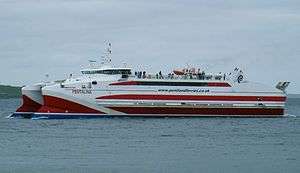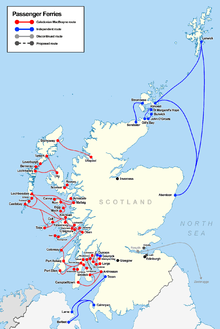Pentland Ferries
Pentland Ferries is a privately owned, family company which has operated a ferry service between Gills Bay in Caithness, Scotland and St Margaret's Hope on South Ronaldsay in Orkney since May 2001. The company is one of only two major vehicle ferry operators plying within Scotland which are not subsidised by the Scottish Government or local authorities.
 | |
| Private Limited with share capital | |
| Industry | Transport |
| Founded | 1997 |
| Headquarters | , |
Area served | Orkney |
| Services | Ferries |
| Owner | Andrew Banks |
| Website | http://www.pentlandferries.co.uk/ |

History
Pentland Ferries was founded by its present managing director, Mr Andrew Banks, in 1997. In October that year he purchased the Caledonian MacBrayne passenger and vehicle ferry Iona. Banks obtained a 99-year lease on the Gills Bay terminal, about 3 miles west of John o' Groats. After two years work improving the site, and further work at St Margaret's Hope, he started operating the short sea crossing with Pentalina B in May 2001. The service operates year-round with the custom built passenger and vehicle catamaran Pentalina.
An earlier attempt to operate the short sea crossing between Caithness and Orkney had been abandoned in 1989, mainly because of the exposed conditions at Gills Bay.
Andrew Banks was recognized in the 2014 Honours list and in March 2014 was awarded an OBE by Queen Elizabeth II. He attended the ceremony at Buckingham Palace with his wife, Susan and three daughters, Kathryn, Laura & Jenni.
Fleet
The current catamaran ferry, MV Pentalina, was built in the Philippines for the Pentland Firth, where it entered service in March 2009.[1] The ferry has a capacity of 350 passengers and either 32 cars and 8 articulated lorries or an increased number of cars, with a service speed of 18 knots.
The original ferry, former Caledonian MacBrayne vessel MV Iona, was purchased in October 1997 and renamed Pentalina-B. The first drive-through MacBrayne ferry with both bow and stern doors, she carried around 50 cars, or 4–5 articulated lorries and fewer cars. During the off-seasons since 2006, she was chartered out, carrying livestock across the channel from Dover and providing freight relief for CalMac. She was sold to an owner in Cape Verde in late 2009.
Another former CalMac vessel, Claymore, was owned between October 2002 and March 2009. After another attempt at starting up the Orkney to Invergordon route fell through,[2][3] the vessel was put to work during the winter season in place of Pentalina-B. Claymore was sold in March 2009.[4]
The fleet also includes a barge, used for dredging at Gills in the summer and an extension to the pier at St Margaret's Hope in the winter, a former fishing boat, to tow the barge and a tug / workboat for general duties. In addition to the usual tractor units and tugs for moving trailers and other cargo equipment there are a number of pieces of construction and earth-moving equipment not usually required by a ferry company.
In February 2015, the company bought a further CalMac vessel, MV Saturn, to be used as a freight vessel.[5]
An order for a new 85m catamaran ferry was placed with Strategic Marine with funding secured from Bank of Scotland. It is being built in a shipyard in Vũng Tàu, Vietnam and was due to enter service in summer 2018.[6] The vessel, named MV Alfred, arrived in St Margaret's Hope on 9 October 2019, and entered service on 1 November 2019.[7]
Route

The Short Sea Crossing is the quickest route across the Pentland Firth by car, taking under 1 hour. Due to the short sailing time the vessels have a cafeteria for meals and refreshments, but no cabin accommodation.
Footnotes
- "Arriving Spring 2008!". Pentland Ferries. Retrieved 9 April 2008.
- "Freight ferry link with Orkney". The Scotsman. 6 November 2002. Retrieved 14 December 2014.
- "News Archives: Pentland Ferries' Invergordon service folds". Orkney News. 25 November – 1 December 2002. Archived from the original on 26 July 2008. Retrieved 28 March 2009.
- "Fleet News". Ships of the North. 11 April 2009. Archived from the original on 5 January 2009. Retrieved 11 April 2009.
- "Pentland Ferries buy another ship". The Orcadian. 17 February 2015. Retrieved 1 October 2018.
- "New Build". Pentland Ferries. Retrieved 1 October 2018.
- "Alfred arrives home". The Orcadian. 9 October 2019. Retrieved 9 October 2019.